Landscape regeneration. Healing from Motocross Track. First Earthworks: Terrace / Retaining Wall, Pocket Pond, Soil decompaction on 400m2 (4300 square feet).
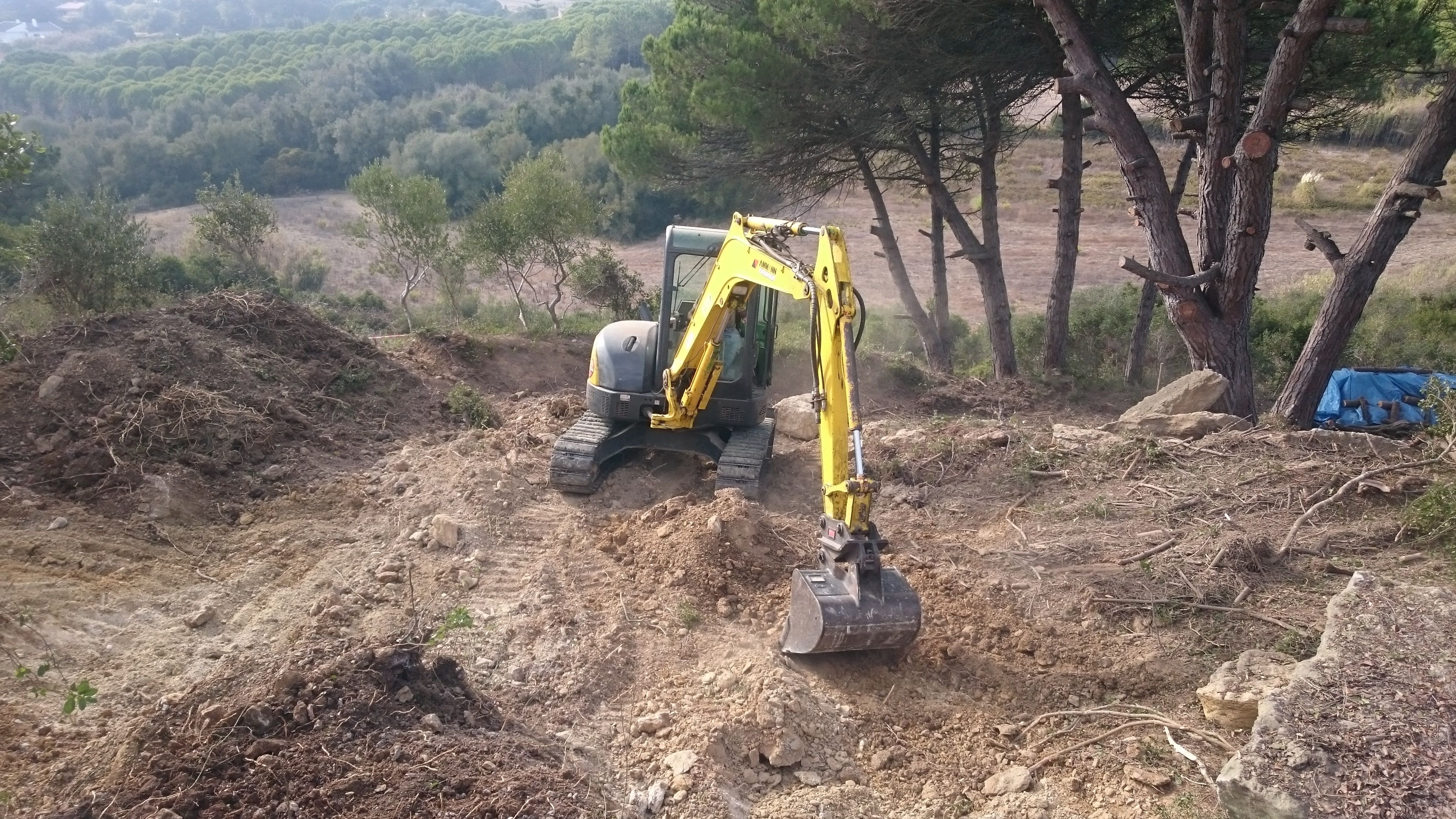
Today I want to share our biggest Permaculture intervention so far. I will talk about our Permaculture earthworks which were our very first action on our „virgin“ property. The land was heavily degraded in a very destinct area of about 400m2 (4300 square feet). That area was part of an offcial Motocross track for a decade, before the wider landscape we live in was declared to be a nature reserve. Ever since the heavily compacted track was sporadically used by weekend drivers and eroding heavily with every rain rushing down the steep track.
As we bought the land we knew from the beginning that we would have to heal this portion of the landscape and kept all our enthusiasm of rushed plantings back for a whole year, as the main permaculture priorities when developing a piece of land clearly state: 1st Water, 2nd Acess, 3rd Structures. You simply don‘t want to pop hundrets of plants or trees into the ground, just to find yourself painfully removing those plants later on, because you found out that their positioning collides with a pond / swale / drain / path / road / fence / barn or house (and so on) that you did not anticipate in the beginning.
Terrace / Retaining Wall.
So here I was in my 7 month PDC course in 2017 slowly filling my brain with all the amazing informations about how to sustainably design a resillient piece of land and had to wait till the end of that course and after my final design exercise to correctly know where all these measures of healing the landscapes motocross wound would be positioned and how they would interact. We are talking about: Terrace / Retaining Rall, Pocket Pond, Spillway, V-drain for erosion control, Silt Trap, Uphill Water Catchemt and Soil Decompaction. All on a quite strongly sloped hillside where I did pay a lot of attention to not create new problems with modified runoff.
Here are some details of my planning process. CAD software and lots of detailed sacled hand drawings where involved to figure this out. The retaining wall you will see further down is marked red in the pencil sketch on the right.

I finally got started with a local excavator operator in mid October 2017 after having layed out the roughest measurements on site. It was a very exciting 3 day experience and the first earthworks I ever planned and conducted.
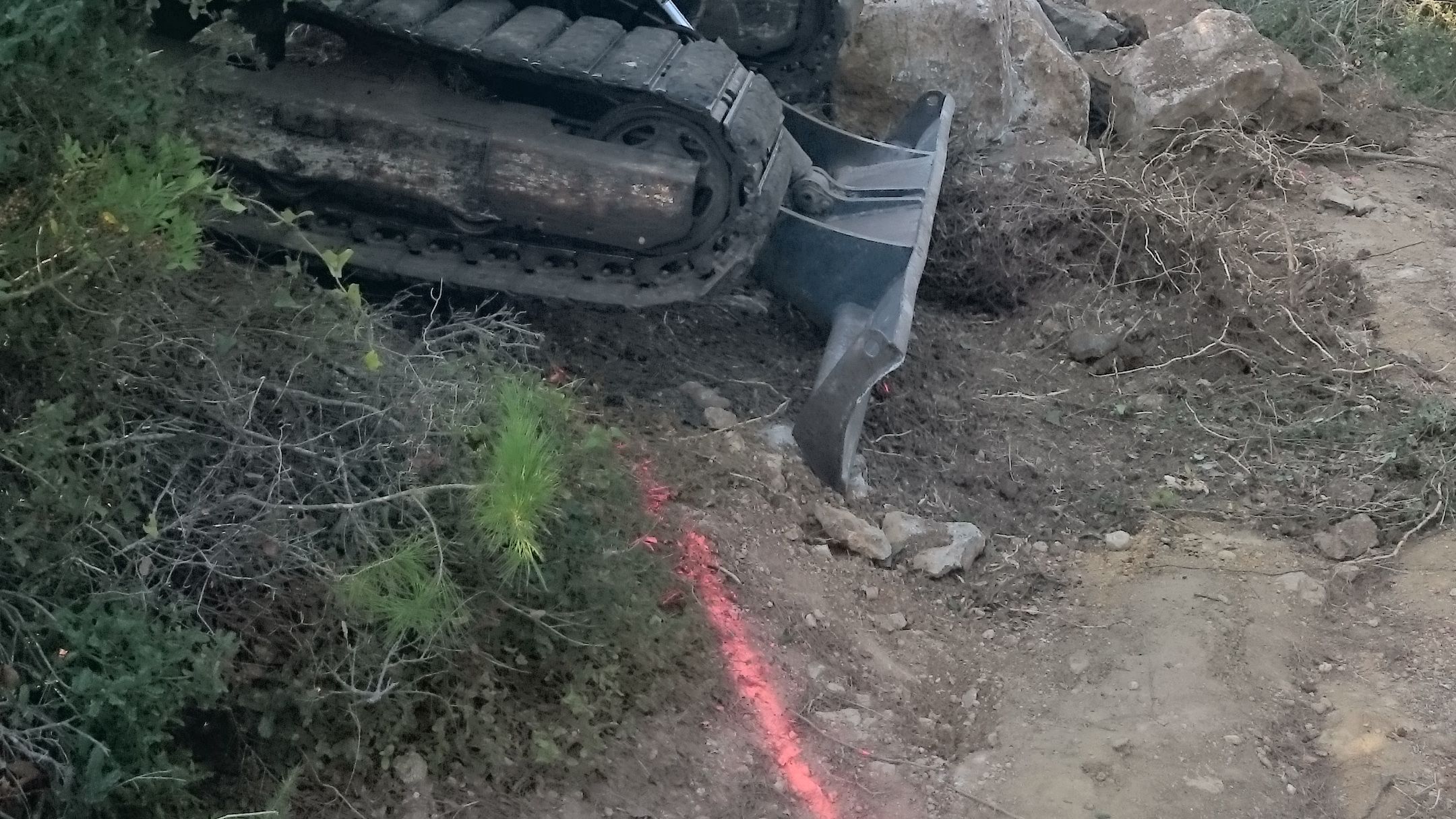
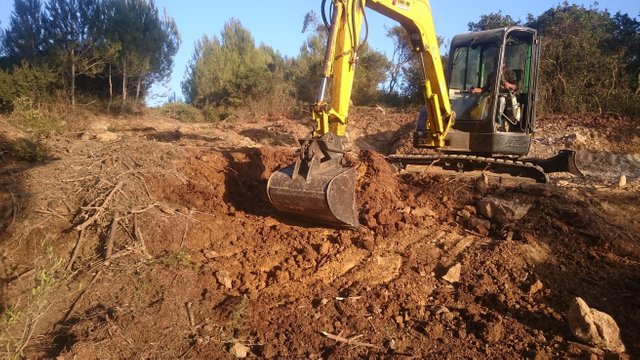
The driver started with the back cut for the terrace and leveled the lower portions of the slope with the diggings to have better ground for navigation. Before any work I kindly asked him to always take off the dark top soil and save it aside, which made it possible to cover all earthworks with dark topsoil again after we where done with the 3 day project.
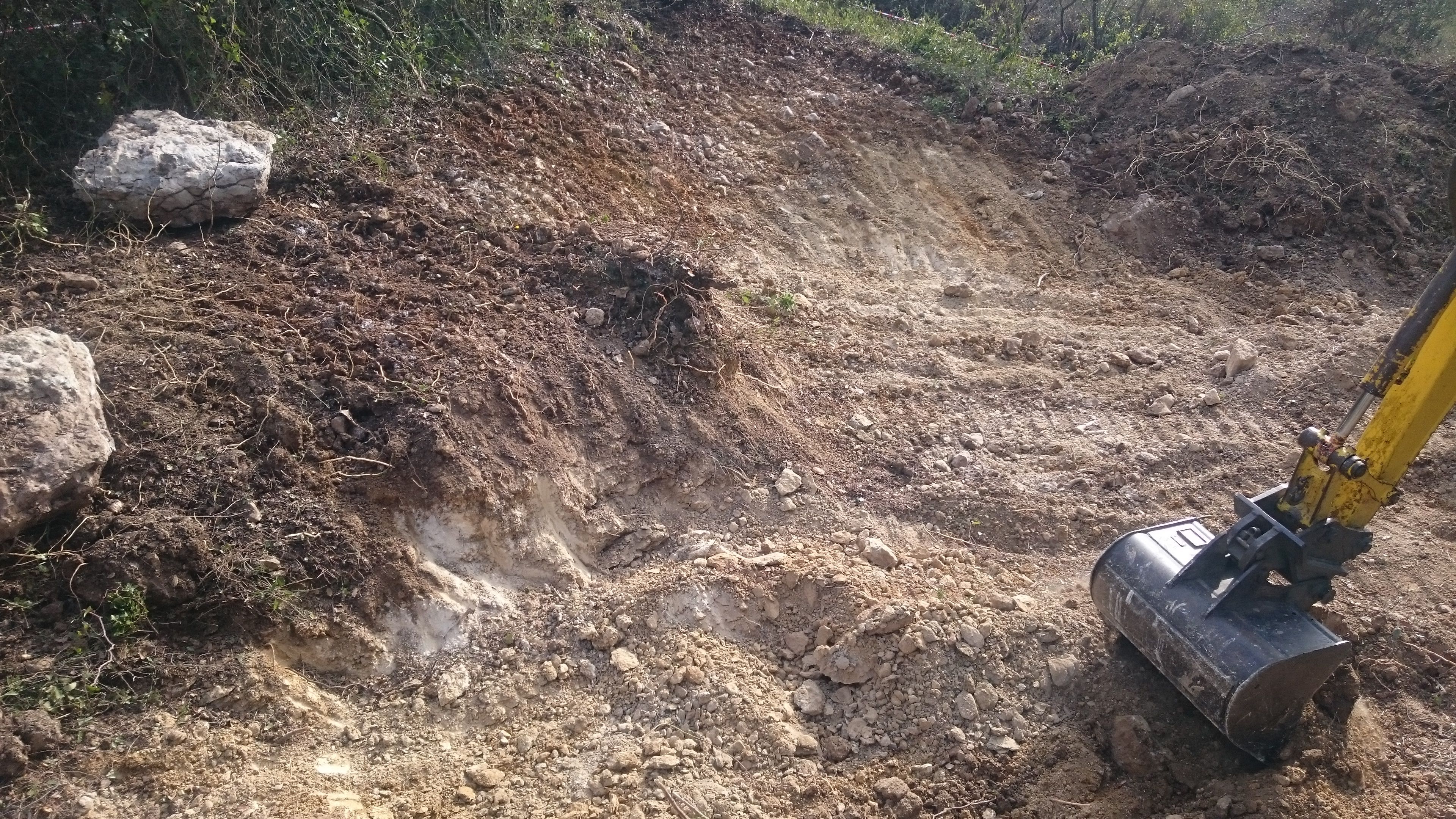

After the rough forming of the terrace the driver palced big bolders on the lower end of it and backfilled the gap with more diggings. The wall holding the new terrace was also extenden to heal the bare roots of a massive stone pine, which where excavated when the track was built. All stone was obtained from on site. Eather from the original moto cross track, where they dumped the bolders on the side of the track, or the stones where excavated by my incredibly gifted excavator driver whithin the work process.
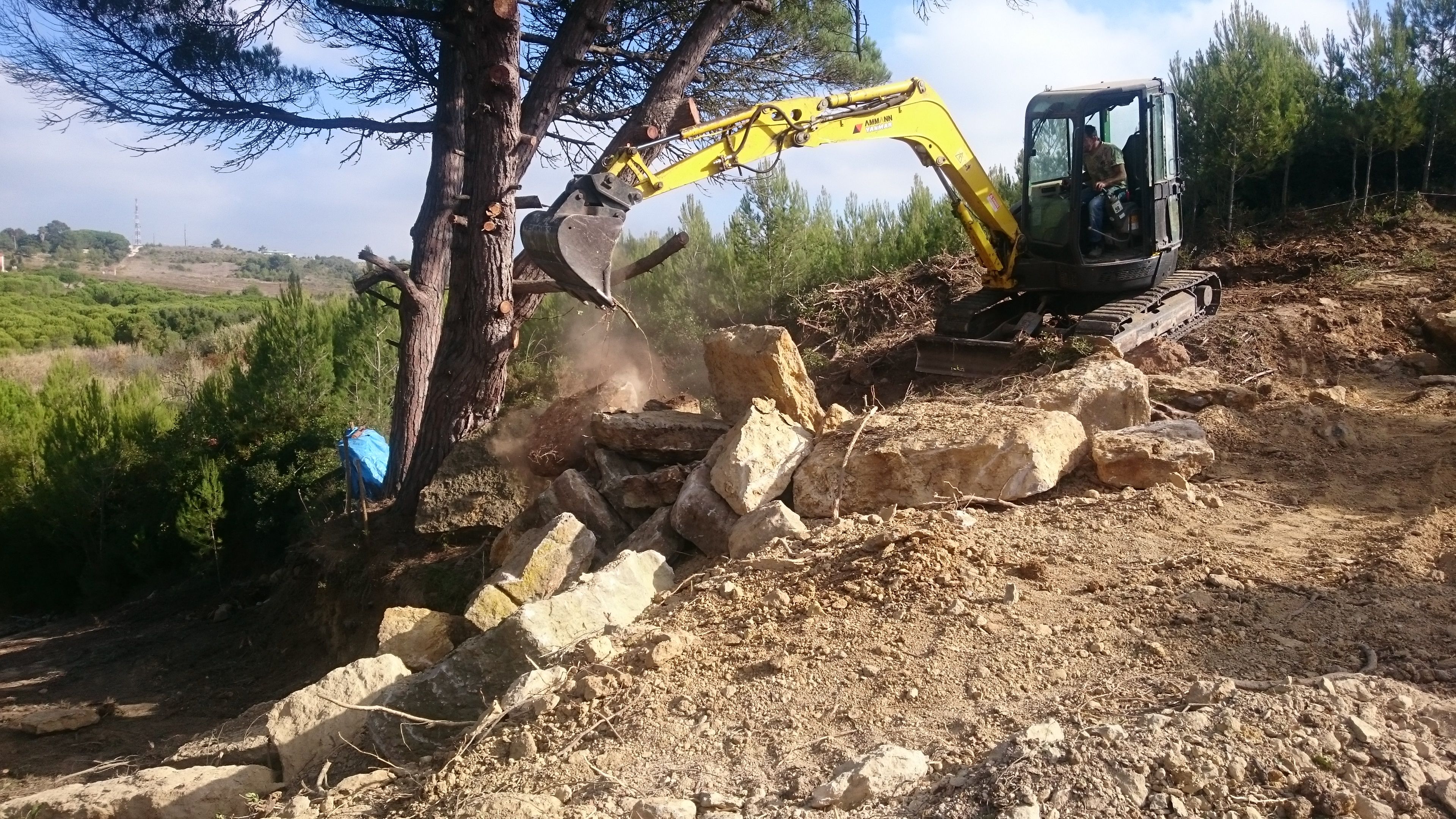
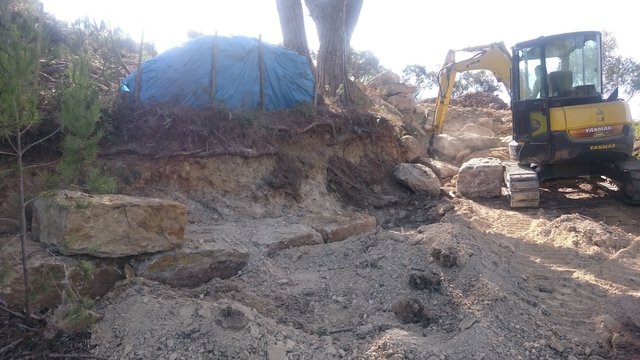
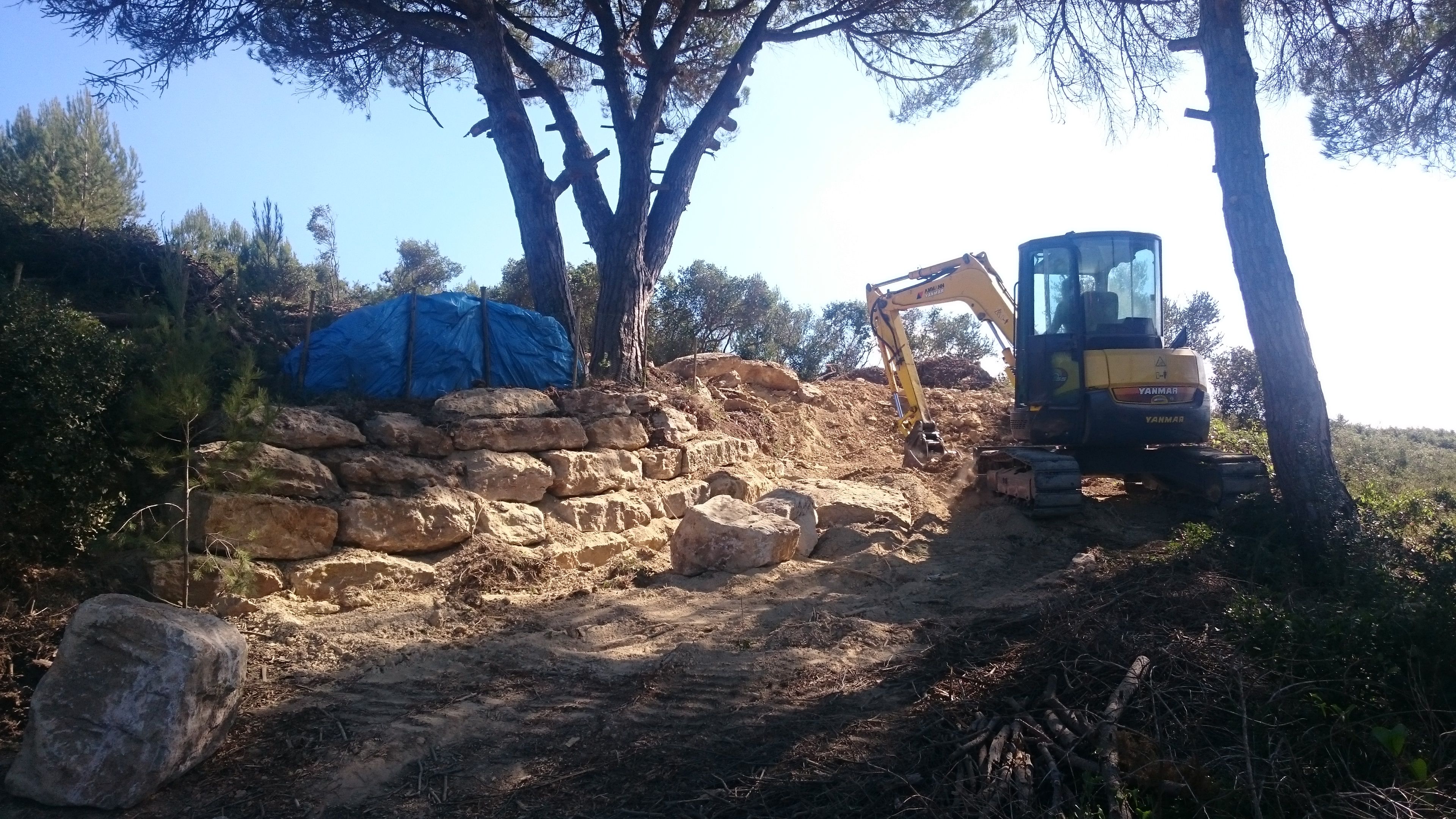
I felt confident, yet I was afraight that someone would tell on us, as what we did was without permit. I tried to get a different permit before here in Portugal, and it took 3 month whithout any help to just reveal more questionmarks from the authorities side without any clear answers. So this time we decided to better ask for forgiveness afterwards than for permission before. All we did was erosioncontrol and lamdscape healing anyways and we asked opur serves: "Who would be upset with us healing the landscape that is nature reserved?"
Here are the final photos of the retention wall and the terrace. The lower parts of the track where just loosened from heavy compaction and topdressed with some rich topsoil we had in excess.
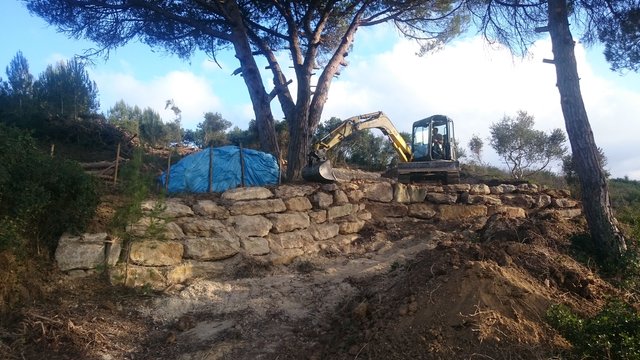
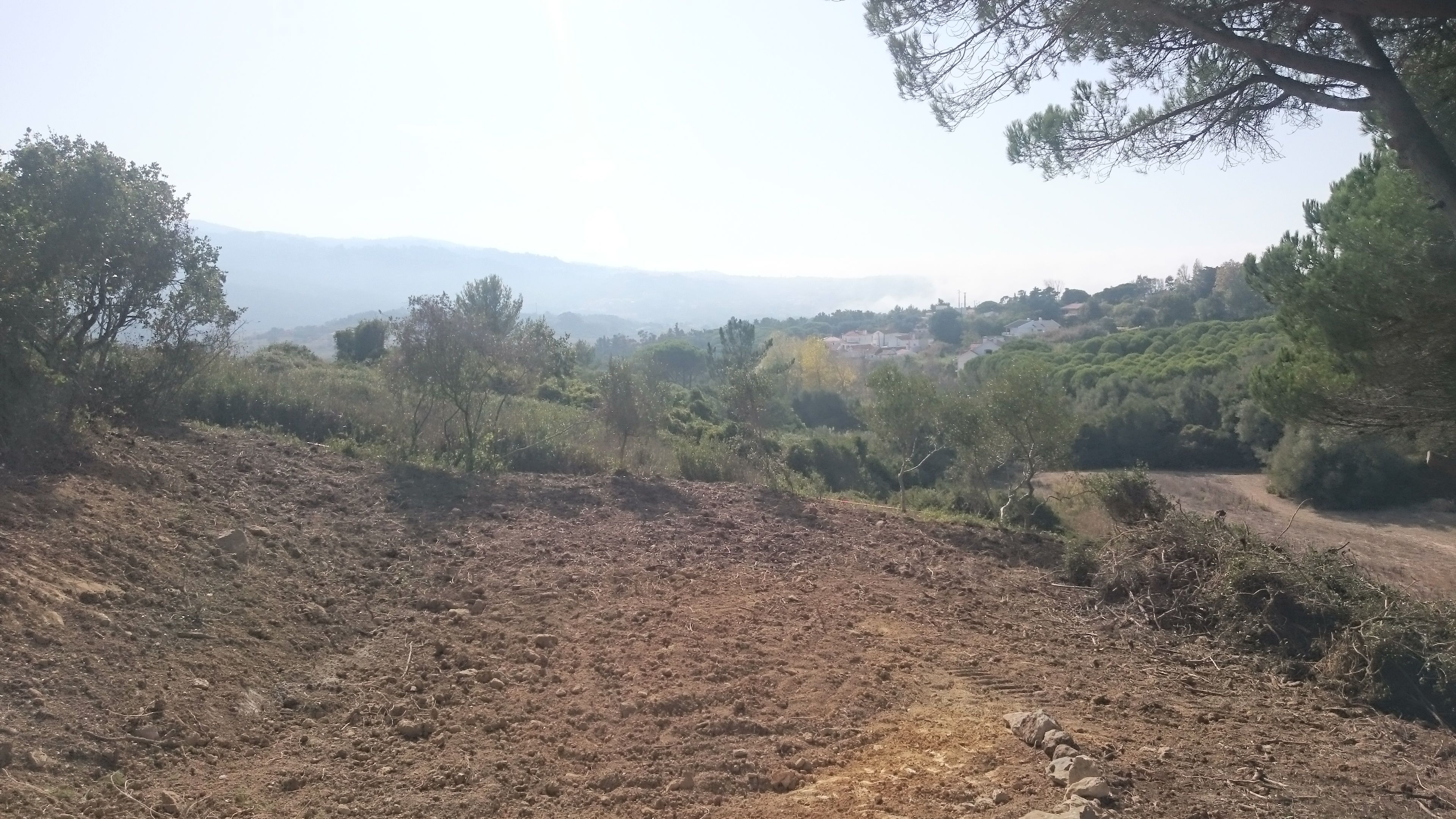
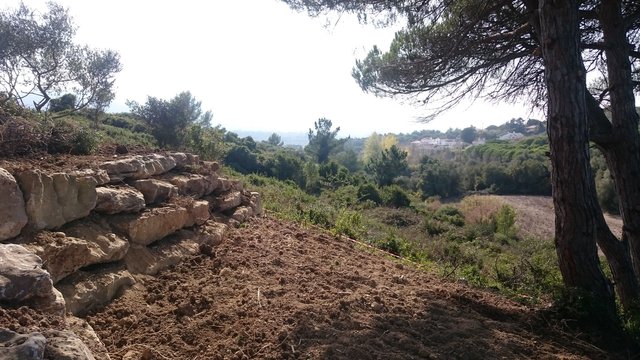
The Pond
While the work for the terrace was on the way I was constantly jumping in the freshly excavated soil and checking the structure of it. A wide variatey of soil structures was revealed during the three days.
The one I was the most exciting about was the high clay content of this one. Check out the traces of the excavator buclet. This shini, almost polished surface hint for very good water holding qualities for ponds!
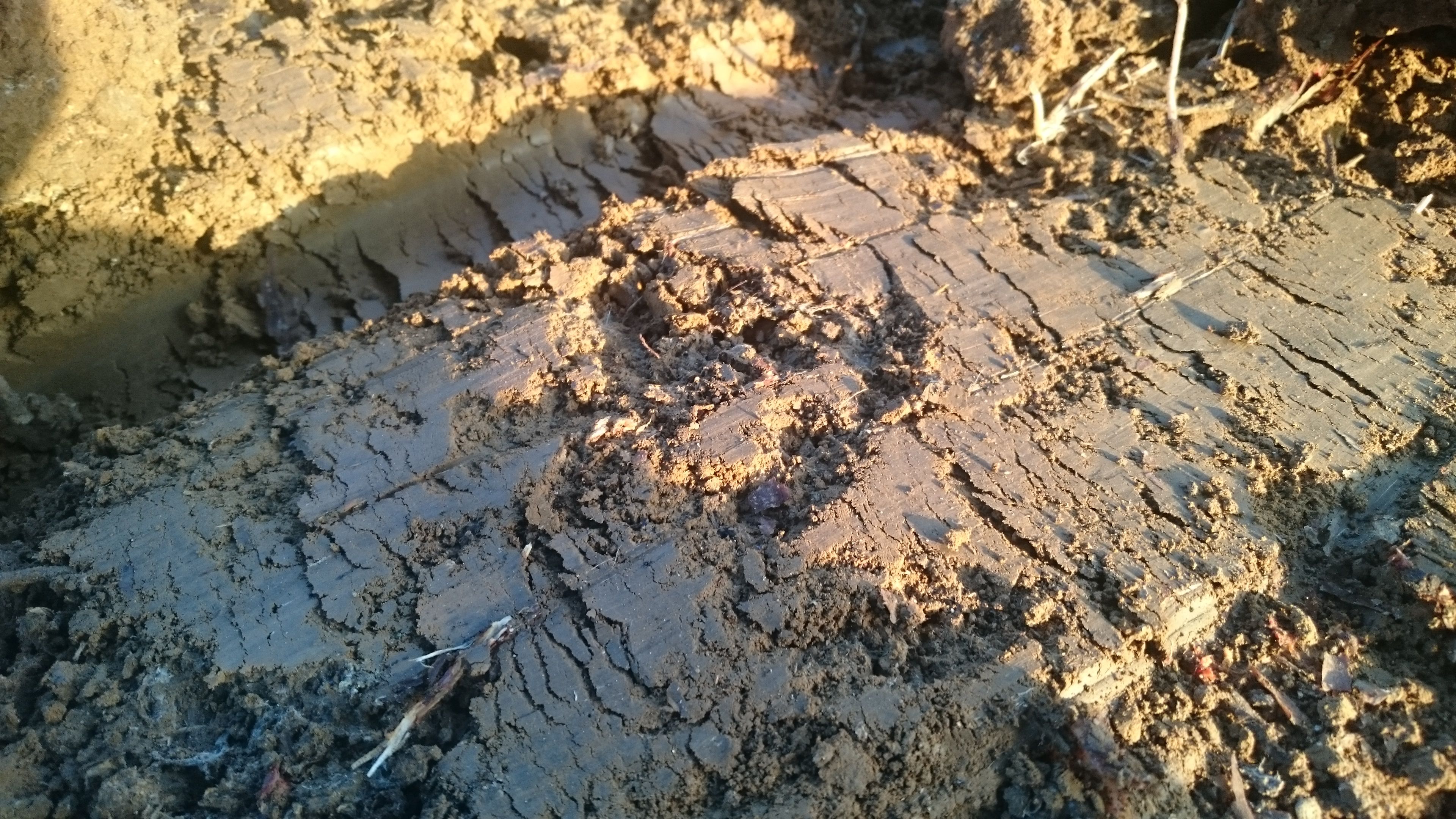
After having finished the terrace I marked out the pond in relation to slope, to the incoming water catchment, the V drain that would bring that water into the pond and the silt trap that had to be installed before the water actually entered the pond. But sadly while digging the pond we crossed the good clay layer and entered this powdery white soil layer, which will most likely not seal. It felt like soft as humid ash while digging and did not hold good after compacting it in my fist.

So here is the pond after the first rain. You see the silt trap fills well, yet the pond does not hold water. The longest period was 5 hours after a heavy rain, where the pond filled about 25 cm, so at the moment it is more like an infiltration pond, which is also functional in our dry mediterranean climate. The more water we can bring into the ground before runnof, the better. I guess I will this pocket pond some more time, maybe the subsoil will saturate and swell, we will see. If the situation will not change I am thinking of turning it into a water infiltrating mulch pit to grow tropicals, but therefore i would need to grow a windbreak and sun trap on the north side. The future will show us the answer to this riddle.
Sorry for this getting a bit lenghty, but as always thank you for listening!
Moritz
Great project, I can't wait to follow your progress on this project.
Thank you @shalomacres!
Waterworks in the landscape are such a huge undertaking. Whay you've done will stand the test of time and improve your land no end.
Exactly right @ligayagardener.
That's why it was important to me to write the 2nd paragraph, as the "Permaculture ritual" 1st Water / 2nd Acess / 3rd Structures is so very important. Water is the real currency of landscape regeneration. After that you align your acess with the water and last come the stuctures..
Thank you for your appreciation.
spot on! It hurts my eyes in Poland. They just keep cutting the grass, burning it and let the very hot dry summers make a duststorm. We are so high in the north and get much rain but in summer we got water issues. Just sad.
We have plenty of earthworks planned for our property and they will be done in stages. This year we will be doing some basics like the drive way and yards site. Doesn't sound like permaculture earth works but will be incorporating a pond and a quasi swale that will shield the driveway from erosion.
We are finding out quickly that the permitting is a nightmare...
Hey @canadianrenegade.
Make shure your pond is as high up in the landscpae as possible, to enable gravity fed water systems for your housing, irrigation or life stock. I don't know is your situation makes this possible but if it does, then go for it as it will be a great life time investement of labour and money!
About your drive way: A swale is a water harvesting and tree growing earthwork. It will hold water for infiltration and destabilize your drive way if installed on the uphill side of your road. The uphill side (the backcut) should definitely be planted in trees if they dont shade the road in winter. If trees will shade out the road, to reduce muddy roads, then the uphill slope needs to be planted with mat rooted plants tp hold the slope better. The uphill side of the road also needs a drain to keep runnoff from the backcut and the road itself. the drain then can be channelt under the driveway in culvert pipes evenry now and then into a swale downhill of the road! And alsways remember. A swale is a water infiltration earthwork and tree growing system.
There are also some more details illustrated in this image from the Permaculture Designers Manual.
Whish you all success possible for your works!
Moritz
Hey, thanks. I saw your message on Discord. I didn't miss your message just been busy and have gotten behind on replying to my comments.
Sounds like lots of good advice. The reason I called it a quasi swale is it isn't really going to hold/infiltrate water. It is just going to be on contour or near contour with one end opening into a pond we will be creating.
There is a low spot the road has to go over where we would have to put a culvert anyway. We are going to dig this area out and use it to build a small damn for the road to roll over. It will only be holding back a couple of feet of water. The majority will be below grade and we will have two overflows. One being a culvert under the road and one being a drain off the other side of the hill away from the road. I might make this one lower so the water never gets up to the culvert.
The only logical place to put our driveway would have it on near contour anyway and putting in Calvert's all along the road means we lose the water into the bush. The subsoil is all gumbo clay so I think it is ideal for this type of project and the pond is quite high on the property. I will have future posts on this project with more details and topographic maps before we actually do the work so maybe you can take a better look over what I am doing then? I am open to suggestions.
Sounds good dear @canadianrenegade.
If I will not see the post due to information overkill, feel free to send me a heads up. I would love to contribute my knowlege to this project!
For now I can only advice, that any culvert is reason to be afraight of erosion. So if not addressed properly, there WILL be problems evolving out of every water running downhill. So make shure to prevent that by any kind of "slowing, spreading, soaking" measures for the culverts.
Also any "quasi swale" that is not completely on contour turns into some kind of very shallow drain. The prevent erosion here in your clayey soil you should not go steeper than 1:500 slope and seed the drain with groundcover right after installing.
Talk to you soon then, and looking forward on your earthworks-posts, as this is one of my favourite permaculture fields.
All the best.
Moritz
Thank you. I will notify you when I post on it. I have the same problem. Just too many posts and follows to keep track of.
Nice to meet you Moritz, I am Matthew and my wife is Aimee. Sometimes she posts /comments on this account but she usually ends her comments with:
-Aimee.
this is absolutely beautiful! the rock work alone! thank you for posting this project!!!
Thank you dear @rawutah. Very much appreciated!
Very impressive, what an inspiring project!!!
Thank you dear @schoonercreek!
I was very lucky to even have received a magical touch with @curie 's wonder wand and lots of fairy glitter sprincled all over :D. Haha. Thank you!
Aren't you curator of @curie as well? Did I remeber that right from your 30 Day steemit post?
That is an impressive terrace wall! Nice going!
It's too bad the pond didn't hold despite all that clay... I wonder why that is. I like how adaptive you are to the situation with multiple possible outcomes and learning on the fly :)
Hey @sagescrub. The pond does not hold, because we digged through that good clay layer. It was not more than 40-50cm deep. After that came the white lime sone powder I hold in my hand.. We will see what time will do to this little infiltration pond. Maybe it seals. I will also do trials with organic matter or pond muck from an other pond.
I see. I have never tried to build a pond before. Thank you for explaining all of this. Good luck with your efforts!
That looks good so far. There always seem to be things that don't go according to plan and then the plan has to be revised. At least this seems to happen to us anyway.
It is always fun to start a new project, or continue an existing one. Have fun! :)
Thank you so much carey-page!
I know that this piece fo land will be a long and intense travel making our lives richer!
OK, first I gotta say, those drawings look great! How did you create the keyline drawing to be so exact at such small scale?
Next, your digger operator is a virtuoso, my friend! I've never seen someone create a dry stone wall with an excavator!
Also, the stone pine, do you get nuts from it?
Finally, our whole soil is like the one you've posted with the slick surface! When they dug the foundation for our house, the sides of the hole were shining and the bucket of the excavator made a screeching sound when digging!
Hey @bobydimitrov.
We had a topographer make a detailed survey for us. I insisted on this, as I studied architecture originally and like to plan things in detail ;)
That our digger is a virtuoso: ABSOLUTELY NO DOUBT!!!! How he was handling these rocks, that actually made the whole excavator tipp over was shear unreal. And do't forget the slope is strong on that piece of land!!!
Stone Pine. Eating nuts, CHECK! Using dry, empty cones to light the Rocket Mass Heater, CHECK! Here in Portugal in December / January there is the pinecone harvesting season, where everybody goes to hunt for bags and bags and bags of these heavy green cones full of rasin. They are sold to resellers, who sell them to resellers, who sell them to the factories, which make the pine nuts you find in the stores.
About your soil being so shiny: do you have slope? do you have catchment uphill? ever thought about making a pond?
The the landscape situation is not perfect for a pond, but we're thinking about it! First, our plot is a small village one, so no space for big ponds. Second, the highest point is where the road and house is. So looking at your drawing, it's something similar, however the pond would be situated 60 meters from the house in the lower parts. There are many things in play, too much for a comment! But the wife insists for a pond. A house first, but a pond also. So I'll probably do a post next year if we get to it!
ps: Here's a photo of the dig I told you about in my previous comment. That's 160 cm deep.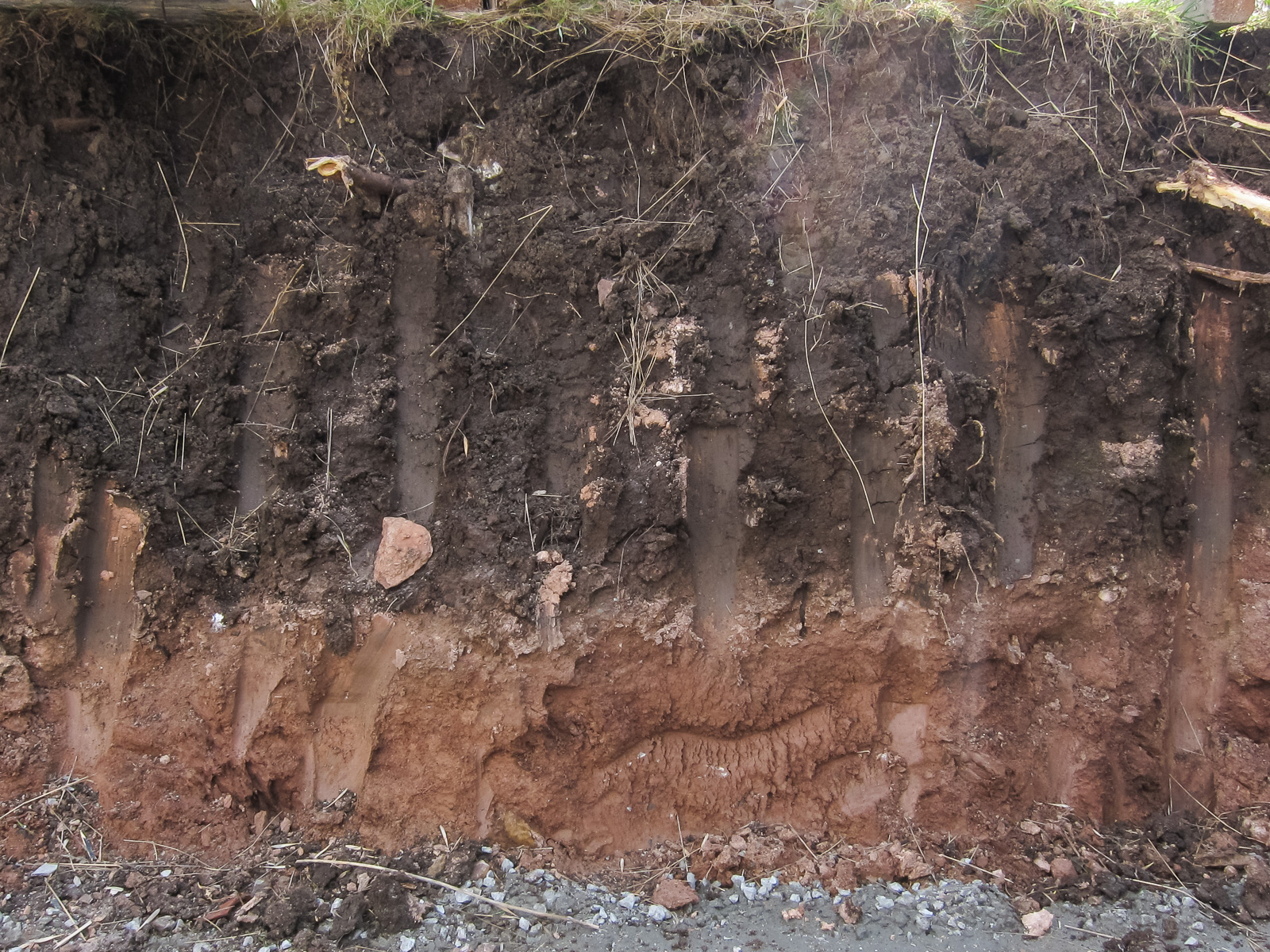
Man you have some serious top soil! That is gold! What is it, 60 cm? That is really a lot!
As a pond you could also just install micro ponds as wildlife habitat. You will see how quickly they will be buzzing with beneficial life!
At that point it's about 100 cm deep :) The reddish subsoil is about 50 cm in this hole. Topsoil is rarely a problem in our part of the country. People here complain about the high clay content, but I personally think that Vertisol is the weekend gardener's best friend! It holds so much waters, that even in August it won't completely dry for 2 week after a 24 hours drip irrigation run.
And adding organic matter in the soil helps a lot!
Amazing! 100cm... incredible! In a no-dig setup with a nice thick compost-mulch the clay content has only positive sides..
I guess the people complain, because the want to dig or plow.... then the clay turns into rock hard chunks.
Hello, I was watching your post, I'm new here and I have a small garden, my brother told me about permaculture, now my project is very small but I want to go there, I'm going to follow you brother and suddenly I ask you one or the other advice since I have a bigger land and I am interested, thank you for your time and good luck!
No problem dear @andresmirabal. Feel free to aks. Always happy to help!
What are your plans with this land? As in are you planning to do something creative? I am going to keep tab if you're planning something creative. :)
Rydhi
xox
Haha. What do you mean by creative? We planned to build a house there in the beginning, yet figured that with two little children and work we would not have time to do so, as the process of getting a permit is extremely exhausting and difficult here..
But we will go on caring for the land, planting food, building huts and sheds.
What do you think?
Haha. That's what I mean if you're planning to build something like greenhouse and pond garden etc. :)
Rydhi